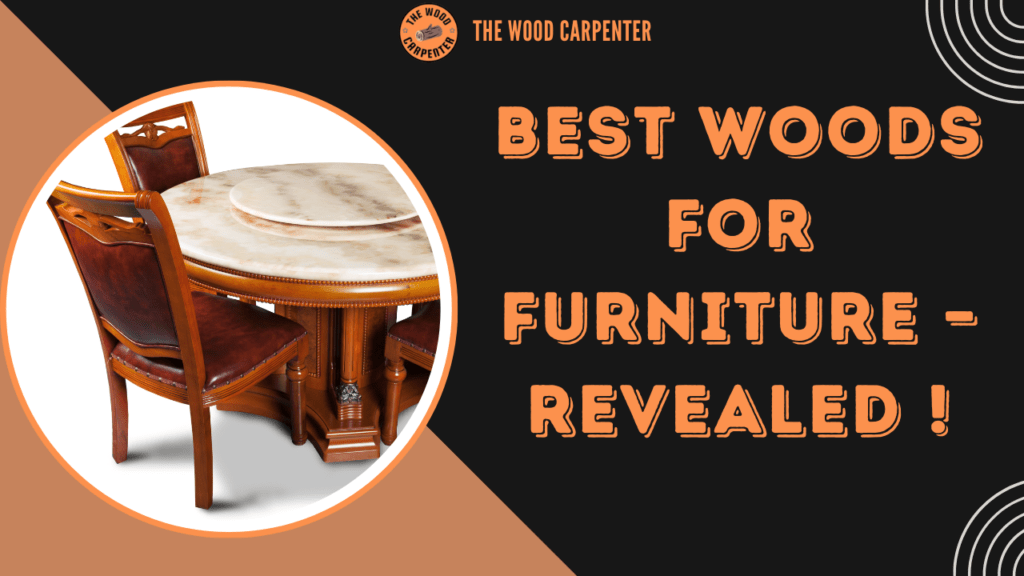
Woodworking has been an important part of human history for centuries and is still one of the most common materials used to make furniture today. When choosing wood for furniture, it’s important to understand the characteristics of each type.
Different types of wood have different features, such as strength, texture, grain, and color. These qualities affect how long the wood will last, how it looks, and how well it works for different types of furniture.
In this blog, we’ll explore 19 types of wood that are commonly used in making furniture. We’ll explain each wood’s unique features, benefits, drawbacks, and the best ways to use them.
1. Mahogany Wood
Description: Mahogany is a classic hardwood treasured for its rich, reddish-brown color that deepens over time. It features a fine, straight grain with a smooth texture.
Uses in Furniture: Ideal for high-end furniture like tables, chairs, cabinets, and beds. Also used for doors, flooring, and decorative accents.
Pros:
- Highly durable and strong.
- Excellent resistance to rot and decay.
- Polishes to a beautiful finish.
- Stable with minimal warping.
Cons:
- Can be expensive and sometimes challenging to source sustainably.
- Sensitive to excessive moisture unless properly treated.
Woodworking Features: Easily worked with hand and machine tools; sands and stains evenly.
2. Yellow Pine
Description: Yellow Pine is a softwood known for its strength and distinctive yellowish color with visible knots.
Uses in Furniture: Common in rustic furniture, cabinetry, and outdoor pieces like decks and garden furniture when treated.
Pros:
- Readily available and affordable.
- Strong and durable when pressure-treated.
- Easy to work with.
Cons:
- Prone to dents and scratches due to softness.
- Can check or split if not properly dried.
Woodworking Features: Accepts nails and screws well but requires pre-drilling to prevent splitting.
3. Douglas Fir
Description: Douglas Fir is a strong, versatile softwood with a straight, uniform grain ranging from pale yellow to reddish-brown.
Uses in Furniture: Often used for structural furniture components, flooring, trim, and joinery.
Pros:
- High strength-to-weight ratio.
- Good dimensional stability.
- Attractive grain for rustic and contemporary styles.
Cons:
- Softer than many hardwoods; prone to surface dents.
- Requires protective finishes for longevity.
Woodworking Features: Machines well, but knots can dull tools.
4. Honduras Mahogany
Description: Honduras Mahogany Often termed Genuine Mahogany, it shares characteristics with other mahoganies but is especially prized for fine cabinetry.
Uses in Furniture: High-end furniture, veneer, paneling, and musical instruments.
Pros:
- Beautiful reddish-brown hue.
- Excellent workability.
- Durable and resistant to insects.
Cons:
- Expensive and regulated for sustainability.
- Can have inconsistent grain patterns.
Woodworking Features: Smooth surface, easy to carve and polish.
5. Iroko Wood
Description: Iroko is a tropical hardwood with golden to medium brown tones, often dubbed African teak due to similar properties.
Uses in Furniture: Both indoor and outdoor furniture, decking, flooring, and boatbuilding.
Pros:
- Naturally resistant to moisture, insects, and rot.
- Dense and durable.
- Attractive coarse grain adds character.
Cons:
- Can cause allergic reactions during work.
- Difficult to work by hand due to density.
Woodworking Features: Holds nails and screws well; requires special tools for smooth finishing.
6. Hickory Wood
Description: Known for toughness, Hickory has a light to medium brown color with a prominent grain pattern.
Uses in Furniture: Heavy-use pieces like kitchen chairs, tables, flooring, and tool handles.
Pros:
- Extremely hard and shock-resistant.
- Visually striking grain.
- Holds up well under wear and tear.
Cons
- Difficult to machine and nail.
- Can be heavy and dense.
Woodworking Features: Takes stain well but requires pre-drilling for fasteners.
7. Ash Wood
Description: Ash has a light color and straight grain with excellent strength and flexibility.
Uses in Furniture: Chairs, cabinets, sports equipment, and bentwood furniture.
Pros:
- Strong yet lightweight.
- Good shock resistance.
- Attractive grain with natural luster.
Cons:
- Less durable outdoors without treatment.
- Prone to insect attack if untreated.
Woodworking Features: Easy to work, sands well, takes paint and stain evenly.
8. Persimmon Wood
Description: Persimmon Wood, a dense, very hard wood with a close grain and brownish tone, usually used in specialty applications.
Uses in Furniture: Small crafted items, tool handles, and specialty furniture accents.
Pros:
- Extremely hard and shock resistant.
- Unique tactile feel.
Cons:
- Not widely available or commonly used for large furniture.
- Difficult to work due to density.
Woodworking Features: Best suited for small detailed work or turning.
9. Sassafras Wood
Description: Sassafras features a yellow to reddish-brown color with a sweet aroma and fine grain.
Uses in Furniture: Specialty furniture, cabinetry, and interior trim.
Pros:
- Durable with good decay resistance.
- Beautiful grain and color.
- Distinctive scent adds character.
Cons:
- Can be scarce depending on region.
- Moderate hardness limits heavy-duty use.
Woodworking Features: Works well with hand and power tools; finishes nicely.
10. Red Oak & White Oak
Description: Both are widely used hardwoods; Red Oak has a warm reddish hue, while White Oak is paler with a tighter grain.
Uses in Furniture: Flooring, cabinetry, tables, chairs, and outdoor furniture (especially white oak).
Pros:
- Durable and strong.
- White Oak is highly water-resistant.
- Readily available and versatile.
Cons:
- Red Oak is less rot-resistant.
- Open grain can require fillers for fine finishes.
Woodworking Features: Easy to stain and finishes well; sanding required for smoothness.
11. Cumaru Wood
Description: Cumaru wood, A tropical hardwood known for durability and hardness, with a rich reddish-brown color.
Uses in Furniture: Outdoor furniture, decking, heavy flooring, and construction.
Pros:
- Extremely wear and weather resistant.
- Dense and heavy.
- Attractive natural color.
Cons:
- Very hard, difficult to machine.
- Heavy weight can limit use in delicate furniture.
Woodworking Features: Requires carbide-tipped tools; finishes to a smooth, glossy look.
12. Maple Wood
Description: Maple wood is a strong hardwood with a fine, closed grain and light creamy color.
Uses in Furniture: Cabinets, dressers, flooring, and fine furniture.
Pros:
- Hard and abrasion-resistant.
- Smooth, uniform texture.
- Takes paint and stain evenly.
Cons:
- Can be prone to blotching when stained.
- Not very moisture resistant; needs sealing.
Woodworking Features: Machinable and finishable; pre-sanding advisable.
13. Ebony Wood
Description: Ebony Wood Known for its striking deep black color, ebony is a dense exotic hardwood.
Uses in Furniture: Decorative accents, inlays, musical instruments, and specialty pieces.
Pros:
- Extremely hard and durable.
- Luxurious appearance.
- Naturally oily, resists moisture.
Cons:
- Very expensive and rare.
- Difficult to work and prone to chipping.
Woodworking Features: Requires sharp tools; best for detailed work.
14. Teak
Description: Teak is prized for its golden brown color and natural oils that protect it from elements.
Uses in Furniture: Outdoor furniture, boatbuilding, cabinetry, and flooring.
Pros:
- Exceptional weather, insect, and rot resistance.
- Ages to a beautiful silver-gray patina.
- Durable and stable.
Cons:
- Often costly.
- Oiliness can make gluing challenging.
Woodworking Features: Works well but may require special adhesives and finishes.
15. Cherry
Description: Cherry wood is a fine-grained hardwood with a rosy patina that deepens with age.
Uses in Furniture: Fine cabinetry, desks, tables, and heirloom pieces.
Pros:
- Smooth texture and excellent finish.
- Ages well with rich color development.
- Easy to shape and turn.
Cons:
- Softer than some hardwoods; prone to dents.
- Sensitive to sunlight exposure.
Woodworking Features: Carves easily and holds detail well.
16. Walnut
Description: Walnut wood is a dark, luxurious hardwood with a fine grain and rich chocolate brown hues.
Uses in Furniture: High-end furniture, veneers, gunstocks, and carving.
Pros:
- Strong yet workable.
- Attractive color and grain.
- Takes finishes very well.
Cons:
- Can be expensive.
- Vulnerable to scratches and dents.
Woodworking Features: Smooth sanding and polishing; excellent for detailed woodworking.
17. Beech
Description: Beech wood is a hard, pale hardwood with a fine grain and smooth texture.
Uses in Furniture: Chairs, stools, tables, and bentwood furniture.
Pros:
- Strong and durable.
- Takes steam bending well.
- Affordable and widely available.
Cons:
- Not highly moisture resistant.
- Can yellow over time.
Woodworking Features: Machines smoothly and glues well; finishes nicely.
18. Pine
Description: Pine wood is a softwood known for its pale yellow color and characteristic knots.
Uses in Furniture: Rustic furniture, shelving, cabinets, and children’s furniture.
Pros:
- Affordable and lightweight.
- Easy to work with.
- Readily available.
Cons:
- Prone to dents and scratches.
- Can warp or shrink if not properly dried.
Woodworking Features: Holds nails well but requires sealing.
19. Zebrawood
Description: Zebrawood is an exotic hardwood with bold dark stripes over a lighter background.
Uses in Furniture: Decorative veneers, inlays, accent furniture pieces.
Pros:
- Stunning visual impact.
- Durable with medium hardness.
- Adds exotic flair.
Cons:
- Can be hard to source sustainably.
- Difficult to work due to interlocking grain.
Woodworking Features: Needs sharp tools and careful finishing.
Final Thoughts
When it comes to choosing wood for furniture, there’s no one-size-fits-all answer. Every type of wood has its own personality — from the rich, timeless beauty of walnut and cherry to the tough, long-lasting strength of hickory and cumaru. The “best” wood really depends on what you’re making, where it will be used, and the style you want to achieve.
Think about how durable it needs to be, how it will handle everyday wear, and of course, whether its look matches your vision. And don’t forget — the right finish can make a huge difference in both protecting the wood and bringing out its true beauty. Pick wisely, and you’ll have a piece of furniture that not only serves its purpose but can be enjoyed for years — maybe even passed down for generations.

